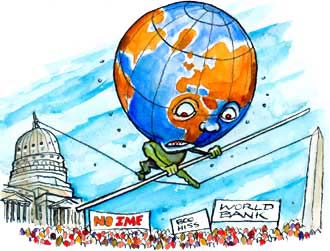Category: Global Economy Sub-category: World Economy
Document type: news
The World Bank has cut its forecast for global growth in the biannual Global Economic Prospects report, citing rising food and fuel prices as the primary causes which are winding out global economic recovery in 2011. The Bank has projected the global growth rate will only be 3.2% in 2011 compared to 3.8% in 2010. The projected growth rate for 2011 is a tenth point lower than the January estimate.  Due to the massive earthquake-tsunami disaster in Japan in March 2011, which interrupted supplies of key parts and materials especially the auto and electronics industries from Japan to global industries, and the political turmoil in West Asia and North Africa region that pushed oil prices higher, the global economy has been mildly affected.
Due to the massive earthquake-tsunami disaster in Japan in March 2011, which interrupted supplies of key parts and materials especially the auto and electronics industries from Japan to global industries, and the political turmoil in West Asia and North Africa region that pushed oil prices higher, the global economy has been mildly affected.
The "high- income" countries are still struggling to recover from the FY09 global financial crisis. The growth rate of these countries will be slowed down from 2.7% in 2010 to 2.2% in 2011, lower than the earlier forecast of 2.4%.
The world's biggest economy, the US, is expected to grow at a feeble rate of 2.6% in 2011 and will be accelerating to 2.9% in 2012. US has been in "a growth pause"; however, chances of a double dip recession in the country have been refuted by its economists and analysts.
The recovery in Europe continues to face "substantial headwinds" from uncertainty about debt crises in several Eurozone members. The 17-nation Eurozone is expected to grow at 1.7% in 2011, same as the 2010 pace and only edging up to 1.8% in 2012.
By contrast, the developing countries have relatively sailed through the global downturn and are providing the impetus for the global recovery. However, their growth is pushing the demand for the goods & commodities upwards, which is threatening to fuel further inflationary pressures.
Global outlook:
-- Global GDP to expand between 2.9 and 3.3% in 2010 and 2011, strengthening between 3.2 and 3.5% in 2012, reversing from 2.1% decline in 2009.
-- Developing economies are expected to grow between 5.7 and 6.2% each year from 2010-2012.
-- High-income countries to grow between 2.1 and 2.3% in 2010 followed by 1.9 to 2.4% growth in 2011.
-- Demand from developing countries will have half the share in global demand from 2010-2012.
Concerns over global recovery:
-- Reduced international capital flows, high unemployment, and spare capacity exceeding 10% in many countries are the main hurdles that can hamper the recovery, according to the report. Expensive credit and decline in investment and growth as a result of continued rising of sovereign debt are the main concerns.
-- The World Bank report assumed that the actions of IMF and European institutions will prevent the crisis while making the projections. But, it cautioned on developing countries having close trade and financial links with high-income countries facing the impact of debt crisis.
-- Irrespective of the debt situation taking shape in Europe, a second round financial crisis cannot be excluded in the countries of developing Europe and Central Asia according to the report. Banking-sector solvency may be threatened due to rising non-performing loans in a slow recovery and high levels of short-term debt.
-- Financing gaps will continue to impact many developing countries with private capital flows to developing countries are forecast to recover only modestly from $454 billion (2.7% of the developing world's GDP) in 2009 to $771 billion (3.2% of GDP) by 2012, compared with $1.2 trillion (8.5% of GDP) in 2007. The financing gap of developing countries is projected to be $210 billion in 2010, declining to $180 billion in 2011, down from an estimated $352 billion in 2009.
-- Over the next 20 years, the fight against poverty and financial inclusion could be hampered if countries are forced to cut productive and human capital investments because of lower development aid and reduced tax revenues.
--------------------------
External Links:
Global Economic Prospects - The World Bank's twice-yearly Global Economic Prospects examines growth trends for the global economy and how they affect developing countries. The reports include three-year forecasts for the global economy and long-term global scenarios which look ten years into the future. Topical annexes in this online publication cover financial markets, trade, commodities, and inflation.
The World Bank - is a vital source of financial and technical assistance to developing countries around the world. Our mission is to fight poverty with passion and professionalism for lasting results and to help people help themselves and their environment by providing resources, sharing knowledge, building capacity and forging partnerships in the public and private sectors.
--









